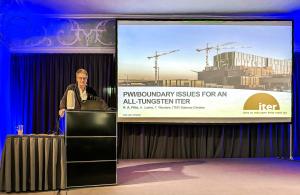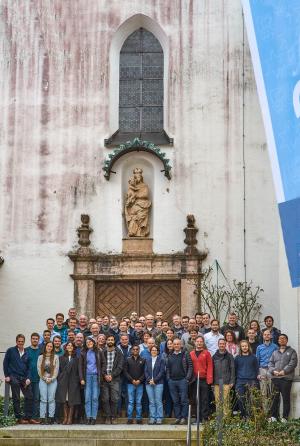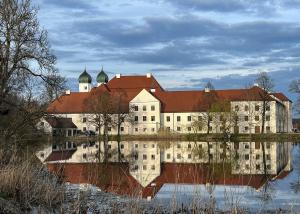ITER and ASDEX Upgrade in the monastic quiet
The ASDEX Upgrade tokamak in Germany has been helping to establish the scientific basis for the optimization of the tokamak approach to fusion energy since 1991. Last month, as the ASDEX Upgrade team met to plan out its next plasma campaigns, ITER was invited to highlight key research needs for operating ITER with a tungsten first wall, particularly in the area of plasma-wall interactions.
In recent years, several medium-sized research tokamaks in the ITER Member facilities have been operating with majority tungsten plasma-facing components, improving confidence that the ITER Organization proposal to modify the ITER wall material is a manageable risk. Nevertheless, some aspects require further experiments and modelling to be more confident in the extrapolation to the ITER scale. It was in this spirit that the Institute of Plasma Physics, Chinese Academy of Sciences, responded to a call from the ITER Organization in October 2023 for support in addressing some of these issues, offering to place the EAST tokamak at the service of ITER for what turned out to be a very successful multi-week plasma campaign at the beginning of 2024. They were not the only ones; teams at the full-tungsten devices WEST (CEA/IRFM Cadarache, France) and ASDEX-Upgrade (Max Planck Institute for Plasma Physics (IPP), Garching, Germany) also engaged. Some dedicated experiments are underway at WEST in the current plasma campaign.
The ASDEX Upgrade facility, on the other hand, is presently nearing the end of a long shutdown for major upgrades to the tokamak, but that does not mean that plans are not being made to support the ITER re-baseline. Following some discussions in late 2023 with experimental program managers, the ITER Organization was invited to attend the first two days of a dedicated week-long retreat (18-22 March) of an important contingent of the ASDEX Upgrade physics team looking ahead to the new plasma campaigns. We were also generously given the opportunity of delivering the opening presentation to highlight key issues requiring further study for ITER operation with tungsten, particularly in the area of plasma-wall interactions.
This wasn't just any ordinary meeting, however. Instead of sitting together in their institute for these discussions, the group convened at the magnificent Kloster Seeon, located on Lake Klostersee, one of the smaller lakes to the north of Lake Chiemsee about 90 minutes drive south east of Munich centre. The site of a former Benedictine monastery, and a self-contained, captive environment, it provides a perfect setting for productive scientific discussion and exchange. Exchange that was not limited to the day time meeting itself, but which continued into the evenings in typical Bavarian fashion.
Gathered at the retreat were members of the IPP team forming what is known internally as the E2/E2M departments, comprising a wealth of experimental and simulation expertise ranging from the H-mode pedestal in the confined plasma region all the way across the cooler peripheral plasma to the bounding surfaces where plasma meets materials. Very productive, dedicated discussions followed the ITER presentation, with some important conclusions reached as to how forthcoming ASDEX Upgrade experiments and plasma materials interaction studies can best address the outstanding ITER questions in this area. The most pressing issues where IPP can make a very significant contribution concern specific tests of the plasma chemical vapour deposition process known as boronization (a wall conditioning technique widely deployed on research tokamaks, and which has been introduced as part of the ITER re-baseline to improve plasma start-up with an all-tungsten wall); the detailed characterization of plasma start-up on tungsten; the impact of a tungsten wall on H-mode performance and the erosion, redeposition and fuel uptake of boron layers. Several of these same issues are also being addressed on WEST and EAST, but in different ways dependent on the specific capabilities of each tokamak. Only by combining results from many sources and using them to benchmark and validate plasma simulation tools, can confidence grow that extrapolations being made for ITER are sound. It has always been so in fusion research and development.
This "monasterial" gathering was not a meeting designed to make detailed plans for the ASDEX Upgrade experimental campaigns—the team will formulate those in the coming months—but to discuss which of the outstanding issues of importance for ITER regarding living with tungsten can be addressed efficiently, on a reasonable timescale, and within the constraints of a program with a great many other research topics on the menu. The ITER Organization looks forward to the upcoming experiments and would like to thank the meeting organizers again for their hospitality and for the opportunity to be part of the discussions.




